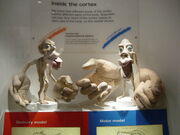No edit summary |
No edit summary |
||
| Line 1: | Line 1: | ||
| + | |||
| ⚫ | |||
==The sensory and motor homunculi== |
==The sensory and motor homunculi== |
||
[[Image:Sensory and motor homunculi.jpg|thumb|Sensory and motor homunculi]] |
[[Image:Sensory and motor homunculi.jpg|thumb|Sensory and motor homunculi]] |
||
| Line 11: | Line 11: | ||
Dr. Philip R. Westlake, a cyberneticist and member of Sigma Xi and noted by journals around the world mentioned the term "homonculi" in his 1968 Ph.D. thesis, "Towards a Theory of Brain Functioning: A Detailed Investigation of the Possibilities of Neural Holographic Processes." Dr. Westlake used the term "homonculi" or "inner eye" to discuss the problem of explaning reconstructed images in the brain. Dr. Westlake wrote in a notation, "This terminology may not be to the taste of everyone. It appears to merit some discussion at least because of its historical connections." |
Dr. Philip R. Westlake, a cyberneticist and member of Sigma Xi and noted by journals around the world mentioned the term "homonculi" in his 1968 Ph.D. thesis, "Towards a Theory of Brain Functioning: A Detailed Investigation of the Possibilities of Neural Holographic Processes." Dr. Westlake used the term "homonculi" or "inner eye" to discuss the problem of explaning reconstructed images in the brain. Dr. Westlake wrote in a notation, "This terminology may not be to the taste of everyone. It appears to merit some discussion at least because of its historical connections." |
||
{{enWP|Homunculus}} |
{{enWP|Homunculus}} |
||
| ⚫ | |||
Revision as of 05:55, 12 April 2006
The sensory and motor homunculi

Sensory and motor homunculi
The homunculus is also commonly used to describe the distorted human figure drawn to reflect the relative sensory space our body parts occupy on the cerebral cortex. The lips, hands, feet and sex organs are considerably more sensitive than other parts of the body, so the homunculus has grossly large lips, hands and genitals. Well known in the field of neurology, this is also commonly called 'the little man inside the brain.'
Dr Wilder Penfield used a similar image to depict the body according to the areas of the motor cortex controlling it in voluntary movement. Sometimes thought to be the brain's map of the body, the motor homunculus is really a map of the proportionate association of the cortex with body members. It also reflects kinesthetic proprioception, the body as felt in motion. It plays a central role in phantom limb phenomena and their opposite such as the disappearance of body members from conscious perception with certain types of brain damage. Like the sensory homunculus, the motor homunculus looks distorted. For example the thumb which is used in thousands of complex activities appears much larger than the thigh with its relatively simple movement. The motor homunculus develops over time and differs from one person to the next. The hand in the brain of an infant is different to the hand in the brain of a concert pianist. This kind of difference is open to introspection. You can probably flex and extend the end of your thumb at will. Most people can do this fairly easily, but relatively few can make analogous movements with any of their other fingers. The difference is due to differences in the functional organization of associated areas of the brain.
See Also: Cortical homunculus
Dr. Philip R. Westlake, a cyberneticist and member of Sigma Xi and noted by journals around the world mentioned the term "homonculi" in his 1968 Ph.D. thesis, "Towards a Theory of Brain Functioning: A Detailed Investigation of the Possibilities of Neural Holographic Processes." Dr. Westlake used the term "homonculi" or "inner eye" to discuss the problem of explaning reconstructed images in the brain. Dr. Westlake wrote in a notation, "This terminology may not be to the taste of everyone. It appears to merit some discussion at least because of its historical connections."
| This page uses Creative Commons Licensed content from Wikipedia (view authors). |
Assessment |
Biopsychology |
Comparative |
Cognitive |
Developmental |
Language |
Individual differences |
Personality |
Philosophy |
Social |
Methods |
Statistics |
Clinical |
Educational |
Industrial |
Professional items |
World psychology |
Biological: Behavioural genetics · Evolutionary psychology · Neuroanatomy · Neurochemistry · Neuroendocrinology · Neuroscience · Psychoneuroimmunology · Physiological Psychology · Psychopharmacology (Index, Outline)